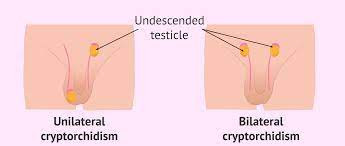Definisi
Undescending testis atau kriptorkidisme adalah kondisi di mana testis (buah zakar) yang tidak turun ke posisi normalnya (kantung buah zakar atau skrotum) dari perut sebelum lahir. Umumnya hanya satu testis yang gagal turun pada kriptorkidisme, namun pada sekitar 10% kasus kedua testis tidak turun.
Pada kebanyakan kasus, testis pada akhirnya akan turun sendiri ke posisi normalnya dalam beberapa bulan pertama kehidupan. Sekitar 3% bayi laki-laki cukup bulan terlahir dengan undescending testis, dan angka kasus menurun menjadi 1% pada bayi yang berusia 6-12 bulan. 30% bayi laki-laki prematur terlahir dengan salah satu atau kedua buah zakar yang tidak turun ke dalam kantungnya. Bila tidak turun dalam waktu lama, prosedur operasi bisa menjadi pilihan pengobatan.
Penyebab
Testis sendiri terbentuk di perut pada saat perkembangan janin. Pada beberapa bulan terakhir perkembangan janin normal, testis akan secara perlahan turun dari perut menuju skrotum melalui saluran di lipat paha yang disebut dengan kanal inguinal. Pada undescending testis, proses ini terhambat atau terhenti.
Penyebab pasti undescending testis terutama pada bayi cukup bulan masih belum diketahui. Diduga ada kombinasi dari faktor genetik, kesehatan ibu ketika hamil dan beragam faktor lingkungan. Kombinasi faktor-faktor tersebut bisa menganggu hormon dan aktivitas saraf, menimbulkan perubahan fisik yang dapat mengganggu perkembangan serta turunnya buah zakar.
Faktor Risiko
Faktor yang dapat meningkatkan risiko terjadinya undescending testis pada bayi baru lahir meliputi:
- Berat badan lahir rendah.
- Berat tali pusat (plasenta) lebih kecil.
- Bayi lahir prematur.
- Ibu memiliki berat badan berlebih (obesitas) saat hamil.
- Ibu menderita diabetes selama hamil.
- Riwayat keluarga dengan undescending testis atau penyakit lain terkait perkembangan alat kelamin lainnya.
- Adanya kondisi janin yang dapat menghambat pertumbuhan, misalnya sindrom Down atau kelainan dinding perut.
- Mengonsumsi alkohol selama hamil (≥5 minuman per minggu).
- Merokok atau terpapar asap rokok selama hamil.
- Terpapar pestisida atau bahan kimia berbahaya selama hamil.
- Preeklampsia (komplikasi kehamilan).
- Bayi tabung.
Gejala
Tanda utama dari undescending testis adalah Anda tidak dapat melihat atau merasakan adanya buah zakar di dalam kantungnya (skrotum), tempat testis normalnya berada. Undescending testis bisa terjadi pada satu atau dua buah zakar, walaupun seringnya terjadi pada buah zakar kanan. Sebagian besar bayi dan anak yang menderita penyakit ini umumnya tidak menunjukkan gejala atau keluhan tertentu. Terkadang bisa ditemukan hernia (penonjolan organ) pada lipat paha.
Diagnosa
Dokter umumnya akan bertanya mengenai keluhan yang menjadi kekhawatiran orang tua, bagaimana riwayat kelahiran anak, riwayat penyakit anak dan keluarga. Dokter juga akan melakukan pemeriksaan fisik dengan melihat serta meraba area buah zakar, perut dan panggul anak. Dokter bisa merekomendasikan pemeriksaan penunjang lanjutan untuk anak Anda bila ada indikasi. Pemeriksaan ultrasound adalah salah satu tes yang bisa dilakukan oleh dokter Anda walaupun tidak terlalu sering dipakai. Sensitivitas dan spesifisitas pemeriksaan ini untuk mencari buah zakar hanya sekitar 45% dan 78%.
Tata Laksana
Bayi baru lahir dengan undescending testis umumnya akan diobservasi selama beberapa bulan pertama kehidupannya. Bila tidak ada masalah, buah zakar akan turun sendiri dalam 3 bulan pertama pada sebagian besar kasus.
Pada anak yang berusia 6-18 bulan di mana buah zakarnya tetap tidak turun, dokter bisa merekomendasikan prosedur operasi untuk mengembalikan testis ke dalam posisi normalnya di kantung skrotum. Tata laksana operasi menurut pendapat para ahli direkomendasikan agar dilakukan sejak dini, ketika anak berusia 6 bulan. Hal ini untuk mengoptimalkan pertumbuhan dan kesuburan dari testis. Pada beberapa kasus, testis mungkin tidak berkembang sempurna, abnormal, atau mati. Dokter akan membuang jaringan testis yang seperti ini.
Dokter akan memanipulasi testis ke dalam skrotum dan menjahitnya supaya tidak berpindah tempat lagi (orchidopeksi). Prosedur ini dapat dilakukan dengan laparoskopi atau operasi terbuka. Waktu dilaksanakannya operasi akan bergantung pada beberapa faktor, seperti kesehatan dan tingkat kesulitan prosedur. Terapi bedah yang lebih awal menurunkan risiko komplikasi di kemudian hari.
Setelah operasi, dokter akan memantau testis untuk melihat apakah testis terus berkembang, berfungsi normal, dan tetap pada tempatnya. Prostesis testis juga bisa dipertimbangkan jika testis tidak bisa diselamatkan dan tidak ada, bertujuan untuk memberikan penampilan normal pada kantung buah zakar.
Komplikasi
Untuk perkembangan testis dan agar testis bisa berfungsi dengan normal, dibutuhkan suhu tubuh yang sedikit lebih sejuk daripada suhu tubuh normal. Suhu kantung buah zakar lebih rendah karena berada di luar tubuh.
Komplikasi yang dapat terjadi ketika testis berada di lokasi yang tidak seharusnya adalah:
- Kanker Testis
Kanker testis biasanya dimulai dari sel di dalam testis yang memproduksi sperma yang tidak matang. Penyebab sel bermutasi menjadi sel kanker masih belum diketahui dengan pasti. Pria yang pernah mengalami undescending testis memiliki risiko lebih tinggi untuk menderita kanker testis. Risiko ini lebih tinggi jika testis berada di dalam perut dan bukan di lipat paha. Risiko juga menjadi semakin lebih tinggi jika kedua testis tidak turun.
- Masalah Kesuburan
Rendahnya jumlah sperma dan kualitas sperma, serta penurunan kesuburan lebih sering terjadi pada pria dengan riwayat undescending testis. Hal ini dapat disebabkan karena gangguan dalam perkembangan testis. Kesuburan dapat semakin terganggu jika kondisi ini tidak ditangani dalam jangka waktu yang lama.
- Torsio Testis
Torsi testis merupakan kondisi terpelintirnya saluran sperma yang mengandung pembuluh darah, saraf, dan saluran yang membawa air mani dari buah zakar ke penis. Terpuntirnya saluran sperma ini akan memotong aliran darah menuju testis. Jika tidak ditangani segera, hal ini dapat menyebabkan kerusakan testis permanen. Torsi testis terjadi 10 kali lipat lebih sering pada pria dengan undescending testis dibandingkan pada testis normal
- Cedera
Jika testis berada di lipat paha, maka dapat terjadi kerusakan akibat tekanan dari tulang pubis.
- Hernia Inguinal
Testis bisa tidak turun ke dalam kantung buah zakar dan malah berpindah ke area lipat paha.
Pencegahan
Tidak ada cara yang diketahui untuk mencegah undescending testis. Namun sebagai orang tua, Anda bisa melihat dan meraba bila kantung buah zakar anak Anda tetap kosong setelah 3-6 bulan sejak ia lahir. Penemuan kasus yang cepat bisa membuat anak mendapat pengobatan lebih dini.
Kapan Harus ke Dokter?
Undescending testis biasanya sudah terdeteksi sejak bayi lahir, dimana setiap bayi yang lahir di fasilitas kesehatan akan melalui pemeriksaan bayi baru lahir. Jika anak Anda mengalami undescending testis, tanyakan pada dokter seberapa sering anak Anda harus menjalani pemeriksaan. Jika buah zakar tidak kunjung turun ke dalam kantungnya sampai anak sudah mencapai usia empat bulan, akan kecil kemungkinan testis akan turun sendiri setelahnya.
Jika Anda menyadari adanya perubahan atau hal yang tidak normal pada kemaluan anak Anda, maka sebaiknya Anda segera berkonsultasi ke dokter.
Mau tahu informasi seputar penyakit lainnya? Cek di sini, ya!
- dr Hanifa Rahma
Undescended testicle - Diagnosis and treatment - Mayo Clinic. (2022). Retrieved 28 July 2022, from https://www.mayoclinic.org/diseases-conditions/undescended-testicle/diagnosis-treatment/drc-20352000
Undescended Testicles: What Is It & Treatment. (2022). Retrieved 28 July 2022, from https://my.clevelandclinic.org/health/diseases/17594-undescended-testicles#prevention
Leslie, S., Sajjad, H., & Villanueva, C. (2022). Cryptorchidism. Retrieved 28 July 2022, from https://www.ncbi.nlm.nih.gov/books/NBK470270/












